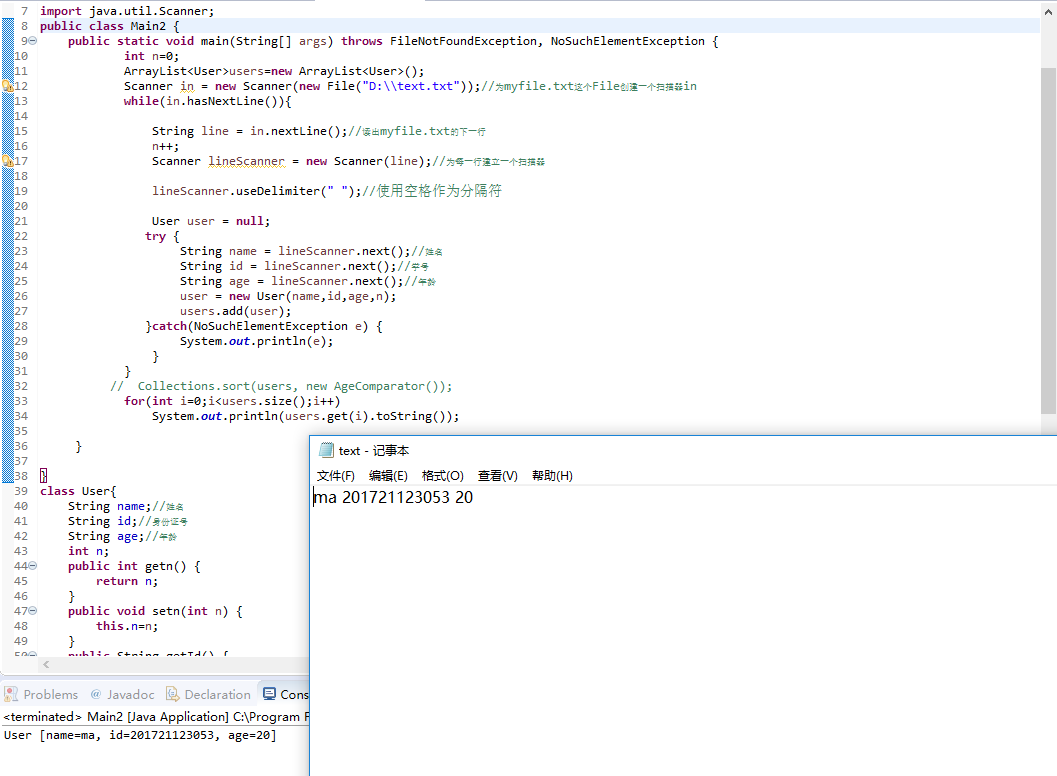6. 为如下代码加上异常处理
6.1 改正代码,并增加如下功能。当找不到文件时,需提示用户找不到文件xxx,请重新输入文件名,然后尝试重新打开。 如果是其他异常则提示打开或读取文件失败!
修改代码如下:
package test;
import java.io.FileInputStream;
import java.io.FileNotFoundException;
import java.io.IOException;
import java.util.Arrays;
import java.util.Scanner;
public class Text {
public static void main(String[] args) {
Scanner sc = new Scanner(System.in);
String file;
byte[] content = null;
FileInputStream f = null;
int flag = 1;
while(flag == 1) {
try {
file = sc.next();
f = new FileInputStream(file);
int bytesAvailabe = f.available();//获取该文件可用字节数
if(bytesAvailabe > 0) {
content = new byte[bytesAvailabe];//创建可容纳文件大小的数组
f.read(content);//将文件内容读入数组
}
System.out.println(Arrays.toString(content));
}catch(FileNotFoundException e) {
System.out.println("找不到文件,请重新输入文件名");
file = sc.next();
}
catch(IOException e) {
System.out.println("打开或读取文件失败");
}
catch(Exception e) {
System.out.println("打开或读取文件失败");
}
finally {
try {
f.close();
System.out.println("关闭文件");
}catch(IOException e) {
System.out.println("关闭文件失败");
}
}
}
}
}
6.2 结合题集6-2代码,要将什么样操作放在finally块?为什么?使用finally关闭资源需要注意一些什么?
- finally语句必执行,所以finally一般用于释放资源。因为不论是否发生异常Finally块中的代码都会被执行。需要注意的是,使用Finally关闭资源时也有可能发生异常,要对其作try-catch处理。
6.3 使用Java7中的try-with-resources来改写上述代码实现自动关闭资源。简述这种方法有何好处?
package test;
import java.io.FileInputStream;
import java.io.FileNotFoundException;
import java.io.IOException;
import java.util.Arrays;
import java.util.Scanner;
public class Main1 {
public static void main(String[] args) throws IOException{
Scanner sc = new Scanner(System.in);
byte[] content = null;
String file = sc.next();
try(FileInputStream f = new FileInputStream(file)){
int bytesAvailabe = f.available();//获取该文件可用字节数
if(bytesAvailabe > 0) {
content = new byte[bytesAvailabe];//创建可容纳文件大小的数组
f.read(content);//将文件内容读入数组
}
System.out.println(Arrays.toString(content));
}catch(FileNotFoundException e) {
System.out.println("找不到文件,请重新输入文件名");
file = sc.next();
}
catch(IOException e) {
System.out.println("打开或读取文件失败");
System.exit(0);
}
}
}
- try-with-resources简化了代码,不需要自己进行close()操作,实现了自动关闭资源的功能。
7. 读取文件并组装对象
7.1 给出关键代码(需出现你的学号)。额外要求:捕获异常时,将错误的信息按照出错原因:行号:该行内容格式输出。
代码
package test;
import java.io.File;
import java.io.FileNotFoundException;
import java.util.ArrayList;
import java.util.NoSuchElementException;
import java.util.Scanner;
public class Main2 {
public static void main(String[] args) throws FileNotFoundException, NoSuchElementException {
int n=0;
ArrayList<User>users=new ArrayList<User>();
Scanner in = new Scanner(new File("D:\text.txt"));//为myfile.txt这个File创建一个扫描器in
while(in.hasNextLine()){
String line = in.nextLine();//读出myfile.txt的下一行
n++;
Scanner lineScanner = new Scanner(line);//为每一行建立一个扫描器
lineScanner.useDelimiter(" ");//使用空格作为分隔符
User user = null;
try {
String name = lineScanner.next();//姓名
String id = lineScanner.next();//学号
String age = lineScanner.next();//年龄
user = new User(name,id,age,n);
users.add(user);
}catch(NoSuchElementException e) {
System.out.println(e);
}
}
// Collections.sort(users, new AgeComparator());
for(int i=0;i<users.size();i++)
System.out.println(users.get(i).toString());
}
}
class User{
String name;//姓名
String id;//身份证号
String age;//年龄
int n;
public int getn() {
return n;
}
public void setn(int n) {
this.n=n;
}
public String getId() {
return id;
}
public void setId(String id) {
this.id = id;
}
public String getAge() {
return age;
}
public void setAge(String age) {
this.age = age;
}
public User(String name,String id,String age,int n) throws NoSuchElementException{
this.name=name;
this.id=id;
this.age=age;
this.n=n;
if(Integer.parseInt(age)<0)
throw new NoSuchElementException("第"+n+"行发生错误: "+"年龄小于于0,不正常" );
}
@Override
public String toString() {
return "User [name=" + name+ ", id="+id + ", age=" + age + "]";
}
}
运行结果

7.2 如果文件有上万行文本,出错的信息可能有很多行,如果将出错信息直接输出到控制台容易被忽略,请问如何解决?
- 解:将所有出错信息存入文件中以便查找。